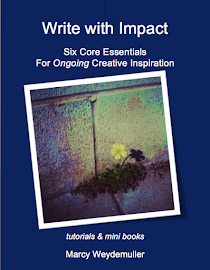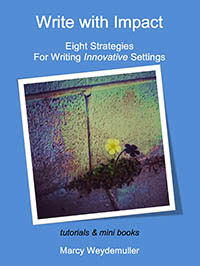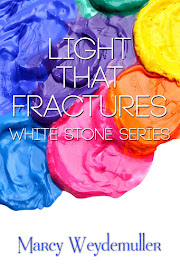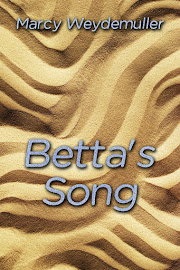Thursday, November 29, 2018
Journal With Impact: Memoir Theme Non-Fiction
Workshop:
Six Conversations for Writing Creative
Journals
Excerpt
from Puerto Rico, Feb 23, 1968, by
Denise Levertov
“…You see how it is—I am
angry that they feel no outrage. Their feelings flow in the wrong directions
and at that wrong intensity. And all I can bring out of my anger is a few
flippant rhymes. What I want to tell you—no, not you, you understand it; what I
want them to grasp is that though I understand that Mitch may have to go to
jail and that it will be a hard time for him and for me, yet, because it’s for
doing what we know we must do, that hardship is imaginable, encompassable, and
a very small thing in the face of the slaughter in Vietnam and the other
slaughters that will come. And there is no certainty he will go to jail.”
The
well-known guidelines for solid nonfiction are still the basic who, what, when,
where, and how, but the undergirding purpose is why.
Curiosity—Communication—Connection.
Nonfiction
sings when curiosity begins a dialogue of interest. When an author has a connection
with their topic and a desire to share, then trust is built.
Focus on the heart
of your topic, your potential audience age, the questions you need to research
for clarity, confirmation of truth, vocabulary, and the impression you desire
to share from your specific experience.
“People
are always interested in other people.” Jane Fitz-Randolph
Find
the Angle. For example, Deloris
Jordan wrote a memoir story for children of her famous son when he struggled
playing basketball at the neighborhood park one particular summer, and how his
commitment turned his despair into success. This one specific insight into this
gifted athlete opened up a whole new generation to recognize love, family,
perseverance, and faith through this true story.
Be
interesting to a broad range Audience. Regardless
of your immediate intended audience look for the themes that are universal and
ageless, and their truths will cross age, race, and culture. Life matters.
Be
Authentic. The research needs to be
solid. If you include interviews be sure to get permission. If you are doing
historical research and find conflicting material give the reasons for the
discrepancy and why it is an issue.
Find
fresh material or Application. For
example, women played a much more dangerous role in many battles, such as World
War ll, that were not acknowledged or revealed at the time due to danger for
them and their work.
The
movie Hidden Figures unveils the three women math geniuses that played such an
important role in NASA. Why did it take so long to release their stories? What
factors will connect to your specific audience and age group? What do you want
to be made open that was hidden?
Action Steps:
Begin
to ask the questions now. Use the italic outline to write
down potential ideas.
1. Who is your intended target audience?
2. What will be the reader expectations be that
you need to include?
3. What overall effect do you want your
readers to leave with?
a. Hope? What kind: emotional, physical,
spiritual?
b. Solutions? What kind: cost, time, and/or
relational?
c. Entertainment: Why? Long term—short term?
4. Write up a
sample outline for an interview to fill in either in person or for research
material.
Share: What did you
choose in step three and why?
Read deep, marcy
A Few Interview
Suggestions
1. Be clear regarding what you want to
discuss.
2. Do the interview in a location that will
make both of you comfortable and at ease without interruptions.
3. Be clear on boundaries and time
commitment.
4. Ask if you can record.
5. Don’t interrupt but note where you would
like more details and ask later for clarification.
6. Build up to any difficult questions. Wait
until the end to ask them.
7. Be considerate of any emotional trauma
your questions create and be sensitive.
8. Offer to show share the material once you
have written it to be sure it’s acceptable to your interviewee before you
publish.
Labels:
Free blog workshop,
Journal with Impact,
Memoir,
Non-Fiction,
Protest Theme,
Six Conversations,
Writing Creative Journals
Thursday, November 22, 2018
Journal With Impact: Memoir Theme Fiction
Workshop:
Six Conversations for Writing Creative
Journals
As I mentioned earlier one approach that Michael J Bugeja
suggests through vignettes is over-arching threads for perspective and voice
and theme. For the next three categories of memoir I’m sharing a few of his
examples using the theme of protest as theme joins perspective and voice in
memoir delivery.
Bugeja
notes that “protest poetry, songs, stories came, I think, in greater quantity
and public awareness during the sixties when anti-war, anti human rights, anti
discrimination became a more public voice. Not that these issues or advocates
had not existed before but the ability or resolve to act upon protest spread. Some
of the protests came in unaccustomed ways, and in fresh voices not seeking
personal gain.”
Whatever
theme we discover in our journals and memories we are looking to share a fresh
voice from one heart to another. Each delivery has its own special strengths
and weaknesses. So first we prepare our musings and then choose which format
best expresses our insights. Fiction—non-fiction—poetry each captures theme in
a different way.
“Fiction
often allows a glimpse into hidden motives or perhaps silent protest. In Invisible Cities, by Italo Cavino, Marco
Polo shares stories of cities with Kublai Khan.”
Here’s
a sound bite from the city Valdrada that speaks volumes.
“At times the mirror increases a thing’s
value, at times denies it. Not everything that seems valuable above the mirror
maintains its force when mirrored. The twin cities are not equal, because nothing
that exists or happens in Valdrada is symmetrical: every face and gesture is
answered, from the mirror, by a face and gesture inverted, point by point. The
two Valdradas live for each other, their eyes interlocked; but there is no love
between them.”
And
a more personal example from Sandra Cisneros, The House on Mango Street in the chapter My Name.
“And the story goes she never forgave him.
She looked out the window her whole life, the way so many women sit their
sadness on an elbow. I wonder if she made the best with what she got or was she
sorry because she couldn’t be all the things she wanted to be. Esperanza. I
have inherited her name, but I don’t want to inherit her place by the window.”
Sometimes
when gathering together your experiences, emotions, and expectations to choose through
which lens you want to present, it is helpful to look at it through a fictional
stance. This way you can view your story as if a reader to gain a neutral
opinion. Then when you have chosen your focus and voice you can return to
nonfiction.
Or
another reason some authors choose a fiction format for their story is if there
are too many missing parts, if for example, you are including family history
before your time and have large gaping holes. Fiction enables you to do
research into the era and events current then. And still be completely engaged
emotionally as the example My Name
captures the atmosphere and circumstances.
Action
Steps:
1. If you have discovered a theme of protest
in your perspective maps and voices then use the following action steps to
develop them further. Or choose another theme that has become more relevant and
substitute it for protest and show it through a “glimpse into hidden motives.”
2. Make a list of times you have protested in
different categories: personal issues, spiritual prayers, anti-…… for community or worldwide issues.
3. Which ones did you protest silently and which out
loud?
4. Choose one that had the most positive outcome and
one the most negative and write each of them as a vignette in either fiction or
non-fiction or both.
Share: Which example on your list
touched your heart with the strongest desire to change?
Read deep, marcy
Note: You can
approach these questions for a real person as well, especially if you are looking
back to a specific time period. Think of them as character development set in a
narrative scene.
What If
Questions For Fictional Characters
Who
is the main Character?
Who
or what is the antagonist?
Who
are the other people in the story?
What
does the main character want?
How
important is it for him to get it?
What
does the antagonist want?
How
does he/it prevent the protagonist?
Results-initial
action
Struggles
lead to (crisis)
Climax
Outcome
Theme
Labels:
Fiction,
Free blog workshop,
Journal with Impact,
Memoir,
Protest Theme,
Six Conversations,
Writing Creative Journals
Thursday, November 15, 2018
Journal With Impact: Memoir Vignette Voices
Workshop:
Six Conversations for Writing Creative
Journals
“We tend to
think of voice as something we hear; it can be squeaky or mellow, loud or soft.
But in writing, voice is what we hear in our head: the medium.”
Barbara Drake
These excerpts are a character study to capture voice. Whereas
in fiction or memoir we have the luxury of developing characterization over a
long period of time, there are sometimes where we only have a brief sentence or
paragraph to highlight a particular characteristic, especially in secondary
characters or for a moment’s insight into a situation. Also our style of
characterization needs to be true to the character. We find our voice—yes—but
it is experienced through the character themselves.
As you continue to build your material, working with
vignettes will help focus the voice you choose and the key perspective. For
example, if sharing from your own personal voice is too raw or complicated to
see through, then use a fictional format to give yourself some separation. The
main character is still you, but by sharing as a third person narrator you can
be more objective alongside sharing your heart.
The
following are three different approaches to discovering the significance and
value in relationships and experiences: as fiction, as interviews, and as
memory. Watch for which words or emotions you respond to, or are curious about.
Fiction
“The Hero
and the Crown,” by Robin McKinley
“Katah was
not the only one that the passing of time did not heal. Galanna’s hair had gone
grey during the first winter, and was white by the time the second spring after
the battle came. She was quieter, and slower, and while she looked with no love
upon Damar’s new queen, she caused, and wished to cause, no more trouble.
Non-Fiction
Memoir
“What She
Couldn’t Tell,” by Patricia Hampl
“I took her
to Mass now and again. I got in the habit of taking her grocery shopping. She
was a wily shopper, her purse bulging with carefully scissored newspaper
coupons which she paid out at the checkout counter like a stack of chips at a
casino. She was gleeful about her strategic buying, by turns petulant over the
price of peaches and contemptuous of what the supermarket thought she would pay
for a cut-up chicken. Ha! She’d cut up her own chicken. I drove her all over
town, stalking deals, running up mileage on my mother’s car.”
Poetry
poem on my
fortieth birthday to my mother who died young
by lucille
Clifton
well i have
almost come to the place where you fell
tripping
over a wire at the forty-fourth lap
and I have
decided to keep running,
head up,
body attentive, fingers
aimed at
darts like first prize, so
I might not
even watch out for the thin thing
Grabbing
toward my ankles but
i’m trying
for the long one mama,
running like
hell and if I fall
i fall.
What
differences, if any, do you notice between these three genres in the way a
character is portrayed? Which one most appeals to you as a voice or style?
Over
the next few blogs we’ll look at each style separately so you can choose your
narrator’s voice.
Action
Steps:
Choose
one or two people either from your own experience, or from photos, for a verbal
vignette snapshot.
1. Write each of them up in three ways. A) As
a brief line description. B) As a non-fiction description memoir style. C) And as
a fictional character in a brief scene.
2. Take one of your descriptions and rewrite
it as a poem.
3. Examine what differences you discovered in
tone of voice between the examples.
Share: Which style
connected the most to the voice you identify with in your memories?
Read deep, marcy
Labels:
Free blog workshop,
Journal with Impact,
Memoir,
Six Conversations,
Vignettes,
Voices,
Writing Creative Journals
Thursday, November 8, 2018
Journal With Impact: Memoir Perspective
Workshop:
Six Conversations for Writing Creative
Journals
“For to remember
is to make a pledge: to the indelible experience of personal perception, and to
history itself.” Patricia Hampl
Now
that you have developed some sensory language, and defined character attributes
and physical locations, the next stage is to extend your seedlings to focus on
relationships, memories, and communication. Look for specific threads where
past history can connect with present history in your personal world.
We
want to be able to connect emotionally with our readers—sometimes across
barriers of language or age or culture. However, often, we first need to
understand how we connect with ourselves. In her study on memoir Patricia Hampl
also notes that it is a landscape bordered by memory and imagination.
Art
and imagery can become a separate language of communication. One way to begin
to explore some aspects applying autobiographical premises and techniques is to
use vignettes, a self-contained prose passage, according to Michael J. Bugeja, which
then can be developed later into narrative, or poetry, or essays, if so
desired.
Consider
vignettes as a series of verbal photographs. These mini snapshots can be seen
through your own personal autobiography or through a fictional character.
Sometimes it helps to lay the groundwork for memoir through a character in
order to set up a scene, especially if you are exploring sensitive issues where
healing still needs to take place. In this situation a certain emotional
distance helps ‘see’ into the truth behind the memory.
One approach that Michael J Bugeja suggests can also
become an over-arching thread for perspective and voice and theme.
Poet as a Visionary can
be a veteran of an experience—someone who has participated in or been an
involved witness or someone who hasn’t—yet gives an overview of events,
sometimes by imagining what it would have been like or has an opinion on the
whole process.
Poet as an Eyewitness
has the experience and gives a first hand account of some aspect. The emphasis
is on impact of the experience whereas the visionary’s emphasis in on
perspective or opinion.
We’ll examine some examples in the next blog as we discuss
voice, but for now look over your maps and see if the words you chose fit
either as a visionary or eyewitness voice.
Action
Steps:
Begin
the shaping process towards an outline and possibly a working table of
contents. Choose one perspective to develop a possible theme thread.
1. Make a list of your key words so far.
2. Next to each write a very brief sentence
that focuses it’s meaning to you then.
3. Next to each mark whether the key is a
location, or a relationship, or a inner revelation. Do any repeat more than
others?
4. Take whichever focus repeats and then set
up a practice outline using that as the foundation.
Share: Which
perspective did you choose and why?
Read deep, marcy
Labels:
Free blog workshop,
Journal with Impact,
Memoir,
Perspective,
Six Conversations,
Writing Creative Journals
Tuesday, November 6, 2018
Journal With Impact: Memoir Maps
Workshop:
Six Conversations for Writing Creative
Journals
“All this
time the Guard was looking at her, first through a telescope, then through a
microscope, and then through an opera glass.” Lewis Carroll
The
lens through which we view or relive our memories will focus the story we want
to share with others. First we take all our brainstorming and look for the
connections. The memories begin to form a shape, a map, from which to outline
and track the journey we want to relive and then to share. Both figuratively
and literally maps can help us go deeper into memoir and give us new insights.
Drawing
maps can combine the brainstorming and concrete research at the same time,
whether you use an existent map to copy from, or design your own. It is another
way to focus on the time, place, and experience that you are exploring.
Here
are some suggestions to experiment with and choose which lens you want to share
from—a long distance reminiscence, a day in the life, or an internal life-changing
experience. Then once you know the style that captures your voice focus on the
action step versions below to fine-tune your story.
Possibilities.
Draw your own setting map, or trace one. Take an old atlas and cut and paste to
make up your own country or local setting. Mimic a tourist map. Take a map and
turn it upside down or backwards. Make a collage of landscapes and buildings.
Research
old maps in a library, make copies, and then turn them into your own. Several
years ago a friend sent me an historical map of a small town in Holland around
the 12th Century. It has figures on the streets showing where
commerce was done. One youth is leading sheep down one path. On another a wagon
is loaded with produce. The people in the village are included along with the
street names.
Any
map can be adapted to your personal visual memories.
Here
is a word sample memory map that is a combination of memoir and creative process
that author George Ella Lyon suggested for beginning poets in her book “Where I’m From.”
I
am unable to copy, sadly, but she took a piece of a traditional map of a
geographic location and then placed the word YOU in the center. Then she
scattered words all over—near the highway, along the river, and in the various neighborhoods.
Here are some of her words—“Town or Street Names, SMELLS, Central Events, Wild
Card, TASTES, Objects, Church Experience, Parent’s Work, and Hiding Place.”
Action
Steps:
1. Choose a
literal map, antique or present, or a photograph of a particular landscape, or
draw your own version with multi-colored pencils, or in black and white with
pens. Or try all three to see which atmosphere most resonates with your
memories.
2. From whichever
map shape or style you chose to work with, make at least three different
versions. A) Literal objects or site names. B) Emotion words or phrases only.
C) Themes or symbols as representatives of your main impressions. Have fun and
draw your own personal emojis.
3. Then from your three approaches mix and
match them as in the sample by George Ella Lyon.
Share: What one key
word did you post on your map that you didn’t expect?
Read deep, marcy
Labels:
Free blog workshop,
Journal with Impact,
Map,
Memoir,
Six Conversations,
Writing Creative Journals
Subscribe to:
Posts (Atom)








